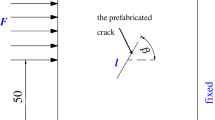Abstract
The crack propagation of rock material is an important research topic in the field of geotechnical engineering, which has important theoretical guiding significance for engineering design, construction, monitoring and maintenance. To explore the effect of prefabricated cracks on the crack propagation and rock failure characteristics of rock, the rock-like material was used to perform uniaxial compression tests on five sets of specimens with prefabricated primary and secondary cracks. It was shown that in all crack combinations, the crack firstly originated from the tip of the primary crack. When the primary and secondary cracks intersected, the crack at the tip of the secondary crack initiated later, and only the end far away from the primary crack initiated; When the primary and secondary crack was separated, the primary and secondary crack tips cracked almost at the same time; All specimens under uniaxial compression were ultimately dominated by tensile failure; the larger the distance between the primary and secondary cracks, the smaller the peak strength and the possibility of penetration.










Similar content being viewed by others
References
Ashby MF, Hallam SD (1986) The failure of brittle solids containing small cracks under compressive stress states. Acta Metall 34(3):497–510
Atkinson Kean B (1984) Subcritical crack growth in geological materials. J Geophys Res 89(B6):4077–4114
Brace WF, Bombolakis EG (1963) A note on brittle crack growth in compression. J Geophys Res 68(12):3709–3713
Chen PY (2018) Research on PFC2D simulation of crack propagation characteristics of cracked rock. J Eng Geol 26(02):528–539 (in Chinese)
Fu JW, Zhu WS, Xie FD, Xue WQ, Zhang DF, Li Y (2013) Experimental studies and elasto-brittle simulation of propagation and coalescence process of two three-dimensional flaws in rocks. Rock Soil Mech 34(09):2489–2495 (in Chinese)
Guo JQ, Liu XR (2018) Study on the uniformity between strength criterion and rockburst criterion. Chin J Rock Mech Eng 37(S1):3340–3352 (in Chinese)
Lange FF (1968) Interaction between overlapping parallel cracks; a photoelastic study. Int J Fract 4(3):287–294
Li SY, Teng CK, Lu ZY, Liu QL, Wu AX, Wu XY (1998) An experimental and theoretical investigation of the dynamic interaction of cracks system—Take the coalescence of collinear shear cracks as an example. Acta Geophys Sin 01:79–89 (in Chinese)
Lin P, Logan JM (1991) The interaction of two closely spaced cracks: a rock model study. J Geophys Res Atmos 96:21667–21675
Song YQ, Li M, Wang X, Li XR, Fu XL (2014) Observation of marble with single pre-existing crack using high-speed photography under loading and unloading conditions. J China Univ Min Technol 43(05):773–781 (in Chinese)
Tang LZ, Song YL (2019) Particle flow simulation of macro- and meso-mechanical properties of uniaxially compressed rock-like specimens with non-coplanar overlapping flaws. Chin J Rock Mech Eng 38(11):2161–2171 (in Chinese)
Tang J, Fang B, Lan Y, Sun CY (2015) Focal mechanism and signal propagation characteristics of micro-seismic induced by fracturing. Oil Geophys Prospect 50(04):643–649+3 (in Chinese)
Yan P, Chen T, Lu WB, Xie LT (2018) A review of dynamic mechanism and controlling of rockburst. Eng J Wuhan Univ 51(01):1–14+26 (in Chinese)
Yang SQ (2013) Study of strength failure and crack coalescence behavior of sandstone containing three pre-existing fissures. Rock Soil Mech 34(01):31–39 (in Chinese)
Zhang BL (2017) Experimental study on edge crack propagation and fracture mechanism in brittle rock-like materials, Doctoral Dissertation of Shandong University of Science and Technology, 32–42 (in Chinese)
Zhang GK, Li HB, Wang MY, Li XF (2019) Crack propagation characteristics in rocks containing single fissure based on acoustic testing and camera technique. Rock Soil Mech 40(S1):63–72+81 (in Chinese)
Zhou WY (1990) Advanced rock mechanics. Hydraulic and Electric Power Press, Beijing (in Chinese)
Zhu SB, Shi YL, Lu M, Xie FR (2013) Study on the dynamic mechanism of earthquake landslide. Sci Sin Terrae 43(07):1096–1105 (in Chinese)
Acknowledgements
This work was supported by Excellent Talents Fund Program of Higher Education Institutions of Liaoning Province (No. LR2018053) and the National Natural Science Foundation of China (51774199).
Author information
Authors and Affiliations
Corresponding author
Additional information
Publisher's Note
Springer Nature remains neutral with regard to jurisdictional claims in published maps and institutional affiliations.
Rights and permissions
About this article
Cite this article
Wang, Z., Wang, J. & Zhang, W. Experimental Study on Failure Characteristics of Rock-Like Material with Prefabricated Primary and Secondary Cracks. Geotech Geol Eng 39, 95–104 (2021). https://doi.org/10.1007/s10706-020-01450-y
Received:
Accepted:
Published:
Issue Date:
DOI: https://doi.org/10.1007/s10706-020-01450-y




